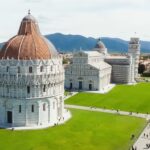
The Strade Bianche according to Ed Hood: The pro peloton moves south to Tuscany from the cobbles of Belgium to the rough white roads and dust of the Strade Bianche. Ed Hood looked at the history and how to ride the white road to the Piazzo del Campo back in 2022.

In January we lost our friend and colleague Ed Hood, two years after his devastating stroke. We will never forget Ed and his knowledge, connections in the cycling world, his writing style and love for the sport. Ed wrote thousands of stunning articles for PEZ, so we will pay homage the ‘King of the Blackberry’ with re-runs of his great work.
And a big thank you to everyone who contributed to Ed’s ‘Go Fund Me’. It made a difference to his last two years.
You can read the PEZ-Crew’s memories of Ed Hood HERE.

The road to Sienna is white and rough
If last weekend’s ‘Opening Weekend’ was eagerly anticipated then cycling fans have another reason to ‘get the beers in’ and hog the television this coming Saturday – The Strade Bianche. The organisers bill it as, ‘Europe’s most southern northern classic,’ far be it from me to differ but the scenery – and usually the weather owe very little to the lands on the shores of the grey and brooding North Sea. The comparison is made because of the tricky surfaces which the competitors have to traverse – but granite cobble sets are just a little bit harder than soft alabaster dust. . .

Dust or clay
Sterrati:
The name given to the strade bianche, or ‘white roads’ which comprises 63 of the race’s 184 kilometres (in 2025 there are 81.7 kilometres of gravel in the 213 kilometres). It’s the alabaster in the soil which gives the sterrati their unique appearance, it’s a soft mineral, often used for carving, and is processed for plaster powder. The ancient Etruscan civilisation – as in GP Costa del Etruschi – were famed for their use of the materiel and it’s still mined in the region.

Etruscan civilisation: Sleep and death carrying off the slain Sarpedon – Etruscan Bronze – Cleveland Museum of Art
Monumental?
As with all else in modern society there’s a push towards the superlative and immediate gratification around this race with a lobby demanding it be given, ‘Monument’ status.
- Liege-Bastogne-Liege: 1894
- Paris-Roubaix: 1896
- Tour of Lombardy: 1905
- Milan-Sanremo: 1907
- Tour of Flanders: 1913
- Strade Bianche: 2007
Now that we’ve cleared that up. . .

The finish line in the Piazzo del Campo
Technique:
A year or two ago I spoke to former Tour de France yellow jersey holder, Rubens Bertogliati about racing on that white dirt;
“In the corners you must be really careful, always using the rear brake and not the front one, it’s very dangerous to attempt front wheel braking – very easy to end up on the dirt.” Rubens also told me that some think it’s better to ride the race in the wet, in those circumstances the surfaces are easier to read.

Rough surface for bike and horse

The first winner of Strade Bianche – Kolobnev
Roll of Honour:
The first winner was Russia’s Alexandr Kolobnev in 2007. Switzerland’s former Olympic Time Trial Champion, Fabian Cancellara is ‘recordman’ on three wins, 2008, 2012 and 2016. Brute strength means a lot in this race. The only other rider to win more than twice is Poland’s former World Road Race Champion, Michal Kwiatkowski in 2014 and 2017 but it’s unlikely he can make it three.

Michal Kwiatkowski – Unlikely third win
Brew of the day?
One can’t go wrong with Peroni Gran Riserva or Moretti – save the Grappa for that final climb to the Campo if your nerves are fraying. . .

Easy on the Grappa
# Keep it PEZ for all the sterrati action on Saturday and catch up with EUROTRASH on Monday. #
The post STRADE BIANCHE: The History and How to Ride the White Road appeared first on PezCycling News.



